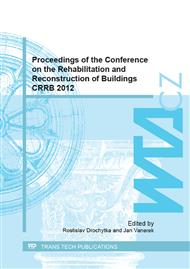[1]
P.V. Krivenko, Alkaline Cements: Terminology, Classification, Aspects of Durability, in: Proceed. of the 10th Inter. Congress on the Chemistry of Cement, Göteborg, Sweden, 1997, Vol.4, 4iv046:6.
Google Scholar
[2]
V.D. Glukhovsky, Soil Silicates, Gosstroyizdat Publish., Кiev, USSR, 1959.
Google Scholar
[3]
V.D. Glukhovsky, Alkaline and Alkali-alkali Earth Hydraulic Binders and Concretes, Vyscha Shkola Publish, Кiev, USSR, 1979.
Google Scholar
[4]
P.V. Krivenko, Special Slag Alkaline Cements, Budivelnik Publish., Кiev, USSR, 1992.
Google Scholar
[5]
P.V. Krivenko, E.K. Pushkaryova, Durability of Slag Alkaline Concrete, Budivelnik Publish., Кiev, USSR, 1993.
Google Scholar
[6]
N.A. Mokhort, Formation of structure and properties of alkaline geocements, in: Tagungsbericht 14 Inter. Baustofftagung "ibausil", Bauhaus Universität Weimar, Bundesrepublik Deutschland. 2000, Band 1, S. 553-560.
Google Scholar
[7]
P.V. Kryvenko, N.A. Mokhort, G.V. Vozniuk, New inorganic binders for gluing concrete, brick and ceramic, in: Proceed. of the ACI Fourth Inter. Conf. "Repair, Rehabilitation and Maintenance of Concrete Structures and Innovations in Design and Construction", Seoul, South Korea, 2000, pp.273-293.
Google Scholar
[8]
N.A. Mokhort, Geozemente zur Strukturbildung im Erhärtungsprozess und ausgewählte Anwendungsbeispiele, in: Beiträge zur Baustoff-Forschung 2001, F.A. Finger-Institut für Baustoffkunde, Bauhaus Universität Weimar, Bundesrepublik Deutschland, Weimar, 2001, S. 212-221.
Google Scholar
[9]
P.V. Kryvenko, N.A. Mokhort, G.V. Vozniuk, Inorganic cements for building materials, in: Beiträge zur Baustoff-Forschung 2001, F.A. Finger-Institut für Baustoffkunde. Bauhaus Universität Weimar, Bundesrepublik Deutschland. Weimar, 2001, S. 222-228.
Google Scholar
[10]
P.V. Kryvenko, O.N. Petropavlovsky, N.A. Mokhort, Industrial uses of geocement-based materials in construction and other industries, in: Proceed. of Inter. Сonf. "Geopolymer 2002". Melbourne, Australia, 2002.
Google Scholar
[11]
N.A. Mokhort, Slag alkaline and geocement concretes on basis of organic filler with high durability, in: Proceed of the Intern. Conf. "Innovations and Developments in Concrete Materials and Construction", University of Dundee, Thomas Telford Publishing, London, U.K., 2002, pp.597-605.
Google Scholar
[12]
N.A. Mokhort, Einfluß von Ausgangzustand und Erhärtungsbedingungen bei der Verfestigung von Geozementen, in: Tagunsgbericht 15 Inter. Baustofftagung "ibausil", Bauhaus Universität Weimar, Bundesrepublik Deutschland, 2003, Band 1, S. 1-0137–1-0143.
Google Scholar
[13]
M. Mokhort, G. Vozniuk, J. Suessmilch, Geocement materials for safety disposal of hazardous, toxic and radioactive wastes, in: Proceed. of Inter. Conf. "Alkali Activated Materials - Research, Production and Utilization", Praha, Czech Republic, 2007, pp.397-412.
Google Scholar
[14]
Yu.M. Butt, V.V. Тimashev, Guide on Chemical Engineering of Binding Materials, Vyschaya Shkola Publish., Moscow, USSR, 1973.
Google Scholar


